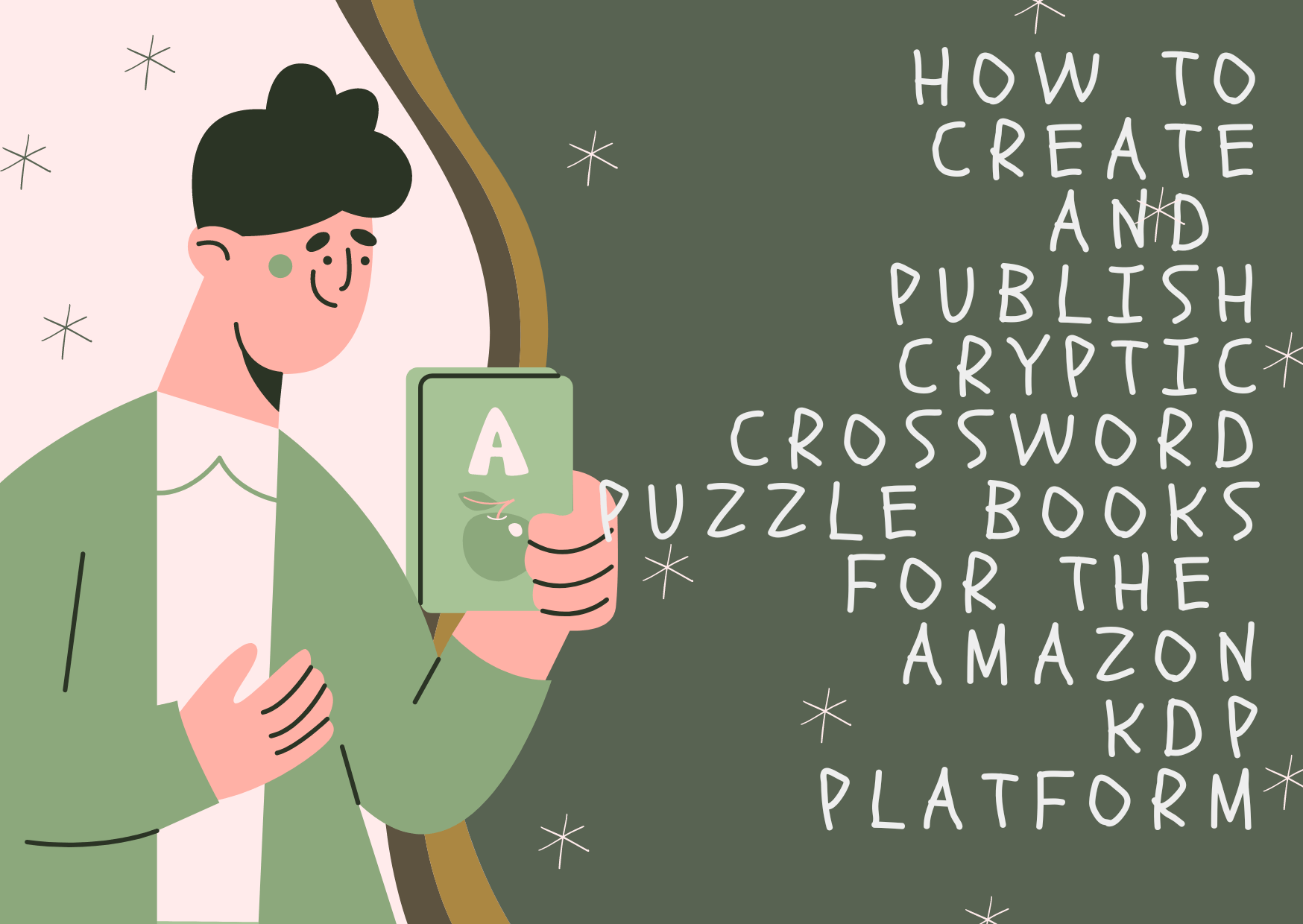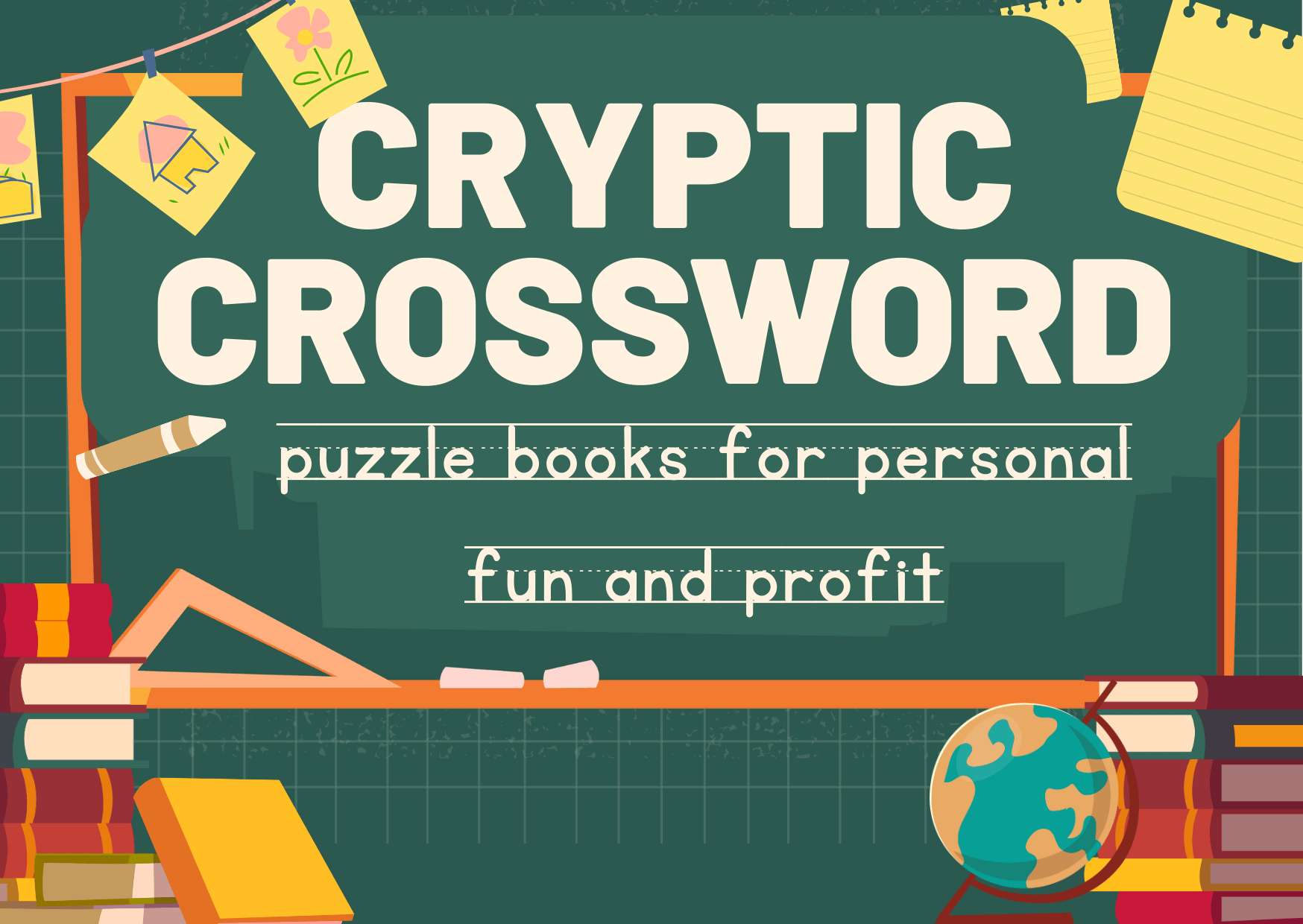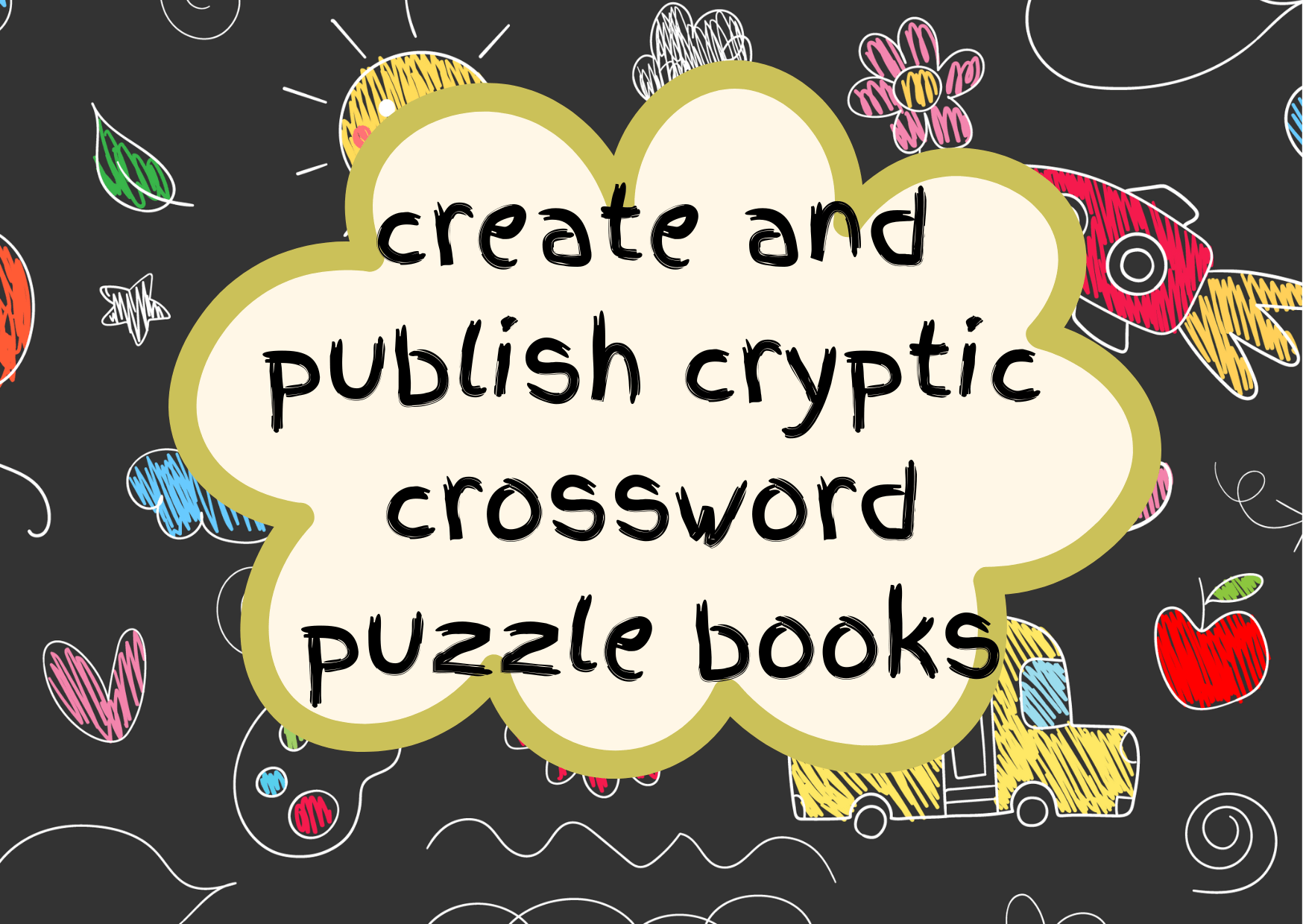cryptic crossword KDP puzzle books: how to play for beginners to advanced strategies, tips and tricks and how to create and sell them
This is a how to article by Saffron
table of contents
- how to solve cryptic crossword puzzles
- detailed explanation of the rules of cryptic crossword puzzles
- tips and tricks on how to quickly solve cryptic crossword puzzles
- advanced strategies for solving cryptic crossword puzzles
- how to make money with cryptic crossword puzzle books

how to solve cryptic crossword puzzles
Solving cryptic crossword puzzles as with math squares puzzle books can be challenging but rewarding. Cryptic crosswords involve deciphering clues that are usually a combination of a definition and a wordplay component. Here's a step by step guide on how to solve cryptic crossword puzzles:
1. Understand Cryptic Clue Components:
Cryptic clues typically consist of two elements: a definition and wordplay. Understanding these components is crucial.
2. Recognize Clue Types:
Cryptic clues come in various types, such as anagrams, hidden words, containers, reversals, and homophones. Familiarize yourself with different clue types to decipher the wordplay.
3. Start with Easy Clues:
Begin with clues that seem more straightforward. These might include anagrams or clues with clear definitions.
4. Look for Indicator Words:
Indicator words signal the type of wordplay used in the clue. Common indicators include "anagram of," "hidden in," "contains," "backwards," and homophone indicators like "sounds like."
5. Anagrams:
If the clue indicates an anagram, rearrange the letters to form a new word. Look for indicator words that suggest mixing or changing the order of letters. This is a pointer can can be applied to reverse word search puzzle books
6. Hidden Words:
Clues may contain words hidden within them. Indicator words like "in," "inside," or "within" suggest that a word is concealed in the given text.
7. Containers and Deletions:
Containers involve one word placed inside another, while deletions require removing certain letters. Indicator words like "around," "holds," or "within" suggest containers, while "missing," "without," or "loses" indicate deletions.
8. Reversals:
If the clue indicates a reversal, the word or part of the word must be read backward. Look for indicators like "back," "returns," or "climbs."
9. Homophones:
Homophones involve words that sound alike. Clues may indicate a homophone using words like "sounds like," "in conversation," or "audibly."
10. Check Crossword Grid:
As you solve clues, check the intersecting words on the grid. This helps confirm your answers and may provide additional hints.
11. Practice GridFilling Strategies:
Fill in as many answers as possible, even if you're unsure about certain clues. The intersecting words may reveal the correct solutions.
12. Use Cryptic Crossword Dictionaries:
Cryptic crossword dictionaries can provide lists of common abbreviations, indicators, and solutions to help you crack tricky clues.
13. Develop a Cryptic Crossword Vocabulary:
Over time, build a vocabulary of abbreviations, indicators, and wordplay techniques commonly used in cryptic crosswords.
14. Be Patient and Persistent:
Cryptic crosswords require practice. Be patient, and don't get discouraged if you can't solve every clue immediately. Patience is also a key factor when solving challenging printable shakashaka puzzle books for kids
15. Seek Help:
If you're stuck, consider seeking help from crossword forums, where experienced solvers may provide hints or explanations.
16. Enjoy the Challenge:
Cryptic crosswords are meant to be challenging and enjoyable. Embrace the mental exercise and the satisfaction of solving each clue. Very soon, even expert level shingoki puzzle books for genius kids will be solvable
By following these steps and practicing regularly, you'll develop the skills and strategies needed to solve cryptic crossword puzzles more confidently.

tips and tricks on how to quickly solve cryptic crossword puzzles
Solving cryptic crossword puzzles efficiently requires a combination of skills, including wordplay interpretation, vocabulary, and pattern recognition. Here are some tips and tricks to help you tackle cryptic crosswords quickly:
Start with Easy Clues: Begin by focusing on the clues that seem more straightforward or familiar. These could include anagrams or clues with clear definitions. Gradually build your confidence as you solve easier clues.
Understand Cryptic Clue Types: Familiarize yourself with different cryptic clue types, such as anagrams, hidden words, containers, reversals, and homophones. Recognizing these patterns will expedite your solving process.
Look for Indicator Words: Pay attention to indicator words that signal the type of wordplay used in the clue. Common indicators include "anagram of," "hidden in," "contains," "backwards," and homophone indicators like "sounds like."
Work with Short Words First: Start with short words or those with common prefixes and suffixes. Three-letter words are often a good starting point, and they can provide clues to neighboring entries.
Use Cross-Referencing: As you solve clues, check the intersecting words on the grid. This can help confirm your answers and provide additional hints for other clues.
Pencil Marks and Abbreviations: Use pencil marks to jot down potential answers in empty squares. Familiarize yourself with common abbreviations used in cryptic crosswords, as they often appear in clues.
Consider the Cryptic Structure: Analyze the structure of the cryptic clue. Identify the components, including the definition and wordplay. Break down the clue systematically to uncover the hidden meaning.
Practice Grid-Filling Strategies: Fill in as many answers as possible, even if you're unsure about certain clues. This can create a foundation for solving other intersecting entries.
Develop a Cryptic Vocabulary: Build a vocabulary of abbreviations, indicator words, and wordplay techniques commonly used in cryptic crosswords. This will enhance your ability to decipher clues efficiently.
Think Outside the Box: Cryptic crosswords often involve thinking creatively and considering multiple meanings of words. Be open to alternative interpretations and word associations.
Seek Help When Stuck: If a clue proves challenging, consider seeking help from crossword forums or crossword-solving communities. Experienced solvers may provide insights or hints without giving away the answer entirely.
Be Patient and Persistent: Cryptic crossword solving is a skill that improves with practice. Be patient, and don't get discouraged if you can't solve every clue immediately. Regular practice enhances your ability to recognize patterns and decipher wordplay quickly.
By incorporating these tips into your solving approach and maintaining a strategic mindset, you'll be better equipped to navigate the intricacies of cryptic crossword puzzles and solve them more rapidly.

advanced strategies for solving cryptic crossword puzzles
Solving advanced cryptic crossword puzzles requires a deeper understanding of wordplay, an extensive vocabulary, and the ability to recognize more intricate clue constructions. Here are some advanced strategies to enhance your cryptic crossword-solving skills:
1. Advanced Wordplay Techniques:
Charades: Some clues involve breaking down a word into separate components, each providing a clue for a part of the solution.
Containers within Containers: Look for clues where one word is placed inside another, and both are integral to the answer.
2. Abbreviations and Acronyms:
Master the use of abbreviations and acronyms, as they are frequently employed in cryptic crosswords. Be aware of standard abbreviations for units, titles, and other common terms.
3. Advanced Anagrams:
Practice solving more complex anagrams where multiple words need rearranging. Anagrams may involve adding or removing letters for an extra layer of difficulty.
4. Double Definitions:
Some clues feature a straightforward definition followed by another definition, often with a different nuance. This double definition adds complexity to the wordplay.
5. Letter Shifts:
Clues may involve shifting or substituting certain letters. This could be indicated by words like "change," "shift," or specific letter indicators.
6. Ximenean Clues:
Familiarize yourself with Ximenean principles, which emphasize fairness and regularity in clue construction. This includes avoiding obscure words and maintaining consistency in wordplay.
7. Theme Awareness:
Be attuned to potential themes within a puzzle. Themes can provide additional hints and make certain clues more decipherable.
8. Nina Detection:
Look for hidden messages or patterns, known as Ninas, within the grid. These can be concealed words or phrases that add an extra layer of complexity.
9. Grid Symmetry and Rotation:
In some advanced puzzles, the grid might have rotational symmetry or other non-traditional symmetrical patterns. Be open to unconventional grid structures.
10. Equate Themes to Clues:
If a puzzle has a theme, consider how theme-related words or concepts might be integrated into the clues. This thematic awareness can aid in solving.
11. Advanced Cryptic Definitions:
Cryptic definitions in advanced puzzles may involve more intricate wordplay, requiring a deep understanding of linguistic nuances and multiple meanings.
12. Vowel Drops and Additions:
Clues might involve dropping or adding vowels to create new words. Pay attention to words like "excluding vowels" or "including vowels" in the clue.
13. XOR and Intersection Clues:
Explore advanced techniques like exclusive OR (XOR) operations, where you consider the combination of letters in intersecting clues to deduce the correct answer.
14. Subset Elimination:
Consider eliminating subsets of possible letters based on intersecting clues. This technique narrows down the potential solutions.
15. Semi-All-in-One Clues:
In semi-all-in-one clues, the entire clue serves as both definition and wordplay. These clues often require more complex mental gymnastics.
16. Flexible Thinking:
Develop the ability to think flexibly and consider multiple interpretations for clues. Words may have more than one meaning or context.
17. Mental Database of Word Patterns:
Build a mental database of word patterns, common letter combinations, and frequently used words in cryptic crosswords. This knowledge aids in rapid pattern recognition.
18. Crossword Puzzle Apps and Advanced Solving Tools:
Some crossword puzzle apps provide advanced solving tools, including features like advanced anagram solvers and pattern matching tools. Familiarize yourself with these resources.
19. Study Advanced Puzzle Constructors:
- Analyze cryptic crosswords constructed by seasoned and expert puzzle creators. This exposure can enhance your understanding of diverse clue constructions.
20. Practice with Variety:
Solve cryptic crosswords from various publications and constructors to expose yourself to a range of styles and constructions. This diversity sharpens your solving skills.
By integrating these advanced strategies into your approach, you'll be better equipped to handle the intricacies of challenging cryptic crossword puzzles and unravel their complexities more efficiently.

how to make money with cryptic crossword puzzle books
Our online puzzle creator streamlines the generation of puzzle books suitable for Kindle Direct Publishing (KDP) in PDF format, focusing on cryptic crossword puzzle books.
Follow these steps to create a puzzle book exclusively featuring cryptic crossword puzzles:
- Click on the cryptic crossword puzzle type within the app.
- Input the details of your puzzle book, specifying the desired number of pages and manuscript dimensions.
- Click the "Generate" button and patiently await the completion of the generation process.
Do not close the tab during the generation process. If there's a delay or an error, initiate the regeneration process. Errors are usually associated with the hosting provider used during app development.
Our online puzzle creator adopts a unique pricing structure, eschewing monthly or yearly subscriptions for a flat rate per manuscript.
Upon generation, the system provides a watermarked preview copy, allowing users to assess and test the puzzle book on various platforms for acceptability.
Satisfied users can proceed to make a one-time payment of $5 to obtain a full manuscript without watermarks.
This pricing strategy aims to provide a fair and transparent cost, avoiding recurring fees for users exploring the full utility of the service. The $5 fee is deemed fair, considering the time and potential expenses saved.
"-to your success"